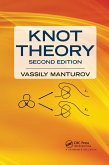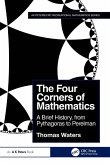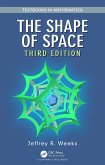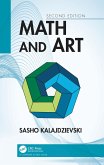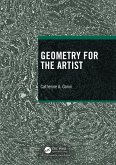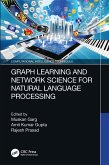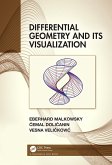Encyclopedia of Knot Theory
Herausgeber: Henrich, Allison; Nelson, Sam; Kauffman, Louis H.; Ludwig, Lewis D.; Flapan, Erica; Adams, Colin
Encyclopedia of Knot Theory
Herausgeber: Henrich, Allison; Nelson, Sam; Kauffman, Louis H.; Ludwig, Lewis D.; Flapan, Erica; Adams, Colin
- Gebundenes Buch
- Merkliste
- Auf die Merkliste
- Bewerten Bewerten
- Teilen
- Produkt teilen
- Produkterinnerung
- Produkterinnerung
This books provides short, interconnected articles on a variety of active areas in knot theory, and includes beautiful pictures, deep mathematical connections, and critical applications edited and contributed to by top researchers in the field of knot theory. The articles in this book are accessible to both undergrads and researchers.
Andere Kunden interessierten sich auch für
![Knot Theory Knot Theory]() Vassily Olegovich Manturov (Russia Moscow State University)Knot Theory79,99 €
Vassily Olegovich Manturov (Russia Moscow State University)Knot Theory79,99 €![The Four Corners of Mathematics The Four Corners of Mathematics]() Thomas WatersThe Four Corners of Mathematics66,99 €
Thomas WatersThe Four Corners of Mathematics66,99 €![The Shape of Space The Shape of Space]() Jeffrey R. WeeksThe Shape of Space71,99 €
Jeffrey R. WeeksThe Shape of Space71,99 €![Math and Art Math and Art]() Sasho Kalajdzievski (University of Manitoba, Winnipeg, Canada)Math and Art83,99 €
Sasho Kalajdzievski (University of Manitoba, Winnipeg, Canada)Math and Art83,99 €![Geometry for the Artist Geometry for the Artist]() Catherine A. GoriniGeometry for the Artist70,99 €
Catherine A. GoriniGeometry for the Artist70,99 €![Graph Learning and Network Science for Natural Language Processing Graph Learning and Network Science for Natural Language Processing]() Graph Learning and Network Science for Natural Language Processing143,99 €
Graph Learning and Network Science for Natural Language Processing143,99 €![Differential Geometry and Its Visualization Differential Geometry and Its Visualization]() Eberhard Malkowsky (Serbia University of Nis)Differential Geometry and Its Visualization126,99 €
Eberhard Malkowsky (Serbia University of Nis)Differential Geometry and Its Visualization126,99 €-
-
-
This books provides short, interconnected articles on a variety of active areas in knot theory, and includes beautiful pictures, deep mathematical connections, and critical applications edited and contributed to by top researchers in the field of knot theory. The articles in this book are accessible to both undergrads and researchers.
Hinweis: Dieser Artikel kann nur an eine deutsche Lieferadresse ausgeliefert werden.
Hinweis: Dieser Artikel kann nur an eine deutsche Lieferadresse ausgeliefert werden.
Produktdetails
- Produktdetails
- Verlag: Taylor & Francis Ltd
- Seitenzahl: 954
- Erscheinungstermin: 29. Dezember 2020
- Englisch
- Abmessung: 184mm x 260mm x 56mm
- Gewicht: 1916g
- ISBN-13: 9781138297845
- ISBN-10: 1138297844
- Artikelnr.: 60017162
- Herstellerkennzeichnung
- Libri GmbH
- Europaallee 1
- 36244 Bad Hersfeld
- gpsr@libri.de
- Verlag: Taylor & Francis Ltd
- Seitenzahl: 954
- Erscheinungstermin: 29. Dezember 2020
- Englisch
- Abmessung: 184mm x 260mm x 56mm
- Gewicht: 1916g
- ISBN-13: 9781138297845
- ISBN-10: 1138297844
- Artikelnr.: 60017162
- Herstellerkennzeichnung
- Libri GmbH
- Europaallee 1
- 36244 Bad Hersfeld
- gpsr@libri.de
Colin Adams is the Thomas T. Read Professor of Mathematics at Williams College, having received his Ph.D. from the University of Wisconsin-Madison in 1983 and his Bachelor of Science from MIT in 1978. He is the author or co-author of numerous research papers in knot theory and low-dimensional topology and nine books, including the text The Knot Book", the comic book Why Knot? and the text Introduction to Topology: Pure and Applied. He is a managing editor for the Journal of Knot Theory and its Ramifications and an editor for the recently published Knots, Low Dimensional Topology and Applications, Springer, 2019. A recipient of the Haimo National Distinguished Teaching Award, he has also been an MAA Polya Lecturer, a Sigma Xi Distinguished Lecturer, and a recipient of the Robert Foster Cherry Teaching Award. He has worked with over 130 undergraduates on original research in knot theory and low-dimensional topology. He is also the humor columnist for the expository math magazine, the Mathematical Intelligencer. Erica Flapan was a professor at Pomona College from 1986 to 2018. From 2000 until 2014, Flapan taught at the Summer Mathematics Program for freshmen and sophomore women at Carleton College, and mentored many of those women as they got their PhD's in mathematics. In 2011, Flapan won the Mathematical Association of America's Haimo award for distinguished college or university teaching of mathematics. Then in 2012, she was selected as an inaugural fellow of the American Mathematical Society. From 2015-2017, she was a Polya Lecturer for the MAA. Since 2019, she has been the Editor in Chief of the Notices of the American Mathematical Society. Erica Flapan has published extensively in topology and its applications to chemistry and molecular biology. In addition to her many research papers, she has published an article in the College Mathematics Journal entitled "How to be a good teacher is an undecidable problem," as well as four books. Her first book, entitled `When Topology Meets Chemistry was published jointly by the Mathematical Association of America and Cambridge University Press. Her second book entitled `Applications of Knot Theory, is a collection of articles that Flapan co-edited with Professor Dorothy Buck of Imperial College London. Flapan also co-authored a textbook entitled ` Number Theory: A Lively Introduction with Proofs, Applications, and Stories with James Pommersheim and Tim Marks, published by John Wiley and sons. Finally, in 2016, the AMS published her book entitled Knots, Molecules, and the Universe: An Introduction to Topology, which is aimed at first and second year college students. Allison Henrich is a Professor of Mathematics at Seattle University. She earned her PhD in Mathematics from Dartmouth College in 2008 and her undergraduate degrees in Mathematics and Philosophy from the University of Washington in 2003. Allison has been dedicated to providing undergraduates with high-quality research experiences since she mentored her first group of students in the SMALL REU at Williams College in 2009, under the mentorship of Colin Adams. Since then, she has mentored 35 beginning researchers, both undergraduates and high school students. She has directed and mentored students in the SUMmER REU at Seattle University and has served as a councilor on the Council on Undergraduate Research. In addition, Allison co-authored An Interactive Introduction to Knot Theory for undergraduates interested in exploring knots with a researcher's mindset, and she co-authored A Mathematician's Practical Guide to Mentoring Undergraduate Research, a resource for math faculty. Allison is excited about the publication of the Concise Encyclopedia of Knot Theory, as it will be an essential resource for beginning knot theory researchers! Louis Kauffman was born in Potsdam, New York on Feb. 3, 1945. As a teenager he developed interests in Boolean algebra, circuits, diagrammatic logic and experiments related to non-linear pendulum oscillations. He received the degree of B.S. in Mathematics from MIT in 1966 and went to Princeton University for graduate school where he was awarded PhD in 1972. At Princeton he studied with William Browder and began working with knots and with singularities of complex hypersurfaces through conversations with the knot theorist Ralph Fox and the lectures of F. Hirzebruch and J. Milnor. From January 1971 to May 2017, he taught at the University of Illinois at Chicago where he is now Emeritus Professor of Mathematics. Kauffman's research is in algebraic topology and particularly in low dimensional topology (knot theory) and its relationships with algebra, logic, combinatorics, mathematical physics and natural science. He is particularly interested in the structure of formal diagrammatic systems such as the system of knot diagrams that is one of the foundational approaches to knot theory. Kauffman's research in Virtual Knot Theory has opened a new field of knot theory and has resulted in the discovery of new invariants of knots and links. His work on Temperley-Lieb Recoupling Theory with Sostences Lins led to new approaches to the Fibonacci model (Kitaev) for topological quantum computing. He has recently worked on representations of the Artin braid group related to the structure of Majorana Fermions. His interdisciplinary research on cybernetics is concentrated on foundational understanding of mathematics based in the act of distinction, recursion and eigenform (the general structure of fixed points). This research is important both for mathematics and for the connections that are revealed in cybernetics with many other fields of study including the understanding of cognition, language, social systems and natural science. Kauffman is the author of four books on knot theory, a book on map coloring and the reformulation of mathematical problems, Map Reformulation (Princelet Editions; London and Zurich [1986]) and is the editor of the World-Scientific Book Series On Knots and Everything. He is the Editor in Chief and founding editor of the Journal of Knot Theory and Its Ramifications. He is the co-editor of the review volume (with R. Baadhio) Quantum Topology and editor of the review volume Knots and Applications, both published by World Scientific Press and other review volumes in the Series on Knots and Everything. Kauffman is the recipient of a 1993 University Scholar Award by the University of Illinois at Chicago. He was also awarded Warren McCulloch Memorial Award of the American Society for Cybernetics for significant contributions to the field of Cybernetics in the same year. He has also been awarded the 1996 award of the Alternative Natural Philosophy Association for his contribution to the understanding of discrete physics and the 2014 Norbert Wiener Medal from the American Society for Cybernetics. He was the president of the American Society for Cybernetics from 2005-2008 and the former Polya Lecturer for MAA (2008-2010). He was elected a Fellow of the American Mathematical Society in 2014. Kauffman writes a column "Virtual Logic" for the Journal Cybernetics and Human Knowing and he plays clarinet in the Chicago-based ChickenFat Klezmer Orchestra. Lewis D. Ludwig is a professor of mathematics at Denison University. He holds a PhD and Master's in Mathematics from Ohio University and Miami University. His research in the field of topology mainly focuses on knot theory, a study in which he engages undergraduate students; nearly a third of his publications involve undergraduate collaborators. Lew created and co-hosted the Undergraduate Knot Theory Conference, the UnKnot Conference, at Denison University which cumulatively supported over 300 undergraduate students, their faculty mentors, and researchers. Lew was a Co-PI and Project Team coordinator for the MAA Instructional Practices Guide Project - a guide to evidence-based instructional practices in undergraduate mathematics. He was creator and senior-editor for Teaching Tidbits blog for the MAA, a blog which provided techniques on evidence- based active teaching strategies for mathematics. Lew won the Distinguished Teaching Award for the Ohio Section of the MAA in 2013 and held the Nancy Eshelman Brickman Endowed Professorship. Sam Nelson is a Professor and Chair of the Department of Mathematical Sciences at Claremont McKenna College. He earned his PhD in Mathematics at Louisiana State University in 2002 and his BS in Mathematics with minor in Philosophy at the University of Wyoming in 1996. A member of UWyo's first cohort of McNair Scholars, he has published 75 papers including over 40 with undergraduate and high school student co-authors, and is co-author of Quandles: An Introduction to the Algebra of Knots, the first textbook on Quandle theory. He has served as the Section Chair of the SoCal-Nevada section of the Mathematical Association of America and is an active member of the Mathematical Society of Japan and the American Mathematical Society, where he has co-organized 17 special sessions on Algebraic Structures in Knot Theory. He sits on the editorial boards of the Journal of Knot Theory and its Ramifications and the Communications of the Korean Mathematical Society, is the recipient of two Simons Foundation Collaboration grants, and was recently honoured as the recipient of Claremont McKenna College's annual Faculty Research Award. When not doing mathematics, he creates electronic music from knot diagrams as independent artist and composer Modulo Torsion.
I Introduction and History of Knots. 1. Introduction to Knots. II Standard
and Nonstandard Representations of Knots. 2. Link Diagrams. 3. Gauss
Diagrams. 4. DT Codes. 5. Knot Mosaics. 6. Arc Presentations of Knots and
Links. 7. Diagrammatic Representations of Knots and Links as Closed Braids.
8. Knots in Flows. 9. Multi-Crossing Number of Knots and Links. 10.
Complementary Regions of Knot and Link Diagrams. 11. Knot Tabulation. III
Tangles. 12. What Is a Tangle? 13. Rational and Non-Rational Tangles. 14.
Persistent Invariants of Tangles. IV Types of Knots. 15. Torus Knots. 16.
Rational Knots and Their Generalizations. 17. Arborescent Knots and Links.
18. Satellite Knots. 19. Hyperbolic Knots and Links. 20. Alternating Knots.
21. Periodic Knots. V Knots and Surfaces. 22. Seifert Surfaces and Genus.
23. Non-Orientable Spanning Surfaces for Knots. 24. State Surfaces of
Links. 25. Turaev Surfaces. VI Invariants Defined in Terms of Min and Max.
26. Crossing Numbers. 27. The Bridge Number of a Knot. 28. Alternating
Distances of Knots. 29. Superinvariants of Knots and Links. VII Other
Knotlike Objects. 30. Virtual Knot Theory. 31. Virtual Knots and Surfaces.
32. Virtual Knots and Parity. 33. Forbidden Moves,Welded Knots and Virtual
Unknotting. 34. Virtual Strings and Free Knots. 35. Abstract and Twisted
Links. 36. What Is a Knotoid? 37. What Is a Braidoid? 38. What Is a
Singular Knot? 39. Pseudoknots and Singular Knots. 40. An Introduction to
the World of Legendrian and Transverse Knots 41. Classical Invariants of
Legendrian and Transverse Knots. 42. Ruling and Augmentation Invariants of
Legendrian Knots. VIII Higher Dimensional Knot Theory. 43. Broken Surface
Diagrams and Roseman Moves. 44. Movies and Movie Moves. 45. Surface Braids
and Braid Charts. 46. Marked Graph Diagrams and Yoshikawa Moves. 47. Knot
Groups. 48. Concordance Groups. IX Spatial Graph Theory. 49. Spatial
Graphs. 50. A Brief Survey on Intrinsically Knotted and Linked Graphs. 51.
Chirality in Graphs. 52. Symmetries of Graphs Embedded in S¿ and Other
3-Manifolds. 53. Invariants of Spatial Graphs. 54. Legendrian Spatial
Graphs. 55. Linear Embeddings of Spatial Graphs. 56. Abstractly Planar
Spatial Graphs. X Quantum Link Invariants. 57. Quantum Link Invariants. 58.
Satellite and Quantum Invariants. 59. Quantum Link Invariants: From QYBE
and Braided Tensor Categories. 60. Knot Theory and Statistical Mechanics.
XI Polynomial Invariants. 61. What Is the Kauffman Bracket? 62. Span of the
Kauffman Bracket and the Tait Conjectures. 63. Skein Modules of 3-Manifold.
64. The Conway Polynomial. 65. Twisted Alexander Polynomials. 66. The
HOMFLYPT Polynomial. 67. The Kauffman Polynomials. 68. Kauffman Polynomial
on Graphs. 69. Kauffman Bracket Skein Modules of 3-Manifolds. XII
Homological Invariants. 70. Khovanov Link Homology. 71. A Short Survey on
Knot Floer Homolog. 72. An Introduction to Grid Homology. 73.
Categorification. 74. Khovanov Homology and the Jones Polynomial. 75.
Virtual Khovanov Homology. XIII Algebraic and Combinatorial Invariants.
76. Knot Colorings. 77. Quandle Cocycle Invariants. 78. Kei and Symmetric
Quandles. 79. Racks, Biquandles and Biracks. 80. Quantum Invariants via
Hopf Algebras and Solutions to the Yang-Baxter Equation. 81. The
Temperley-Lieb Algebra and Planar Algebras. 82. Vassiliev/Finite Type
Invariants. 83. Linking Number and Milnor Invariants. XIV Physical Knot
Theory. 84. Stick Number for Knots and Links. 85. Random Knots. 86. Open
Knots. 87. Random and Polygonal Spatial Graphs. 88. Folded Ribbon Knots in
the Plane. XV Knots and Science. 89. DNA Knots and Links. 90. Protein
Knots, Links, and Non-Planar Graphs. 91. Synthetic Molecular Knots and
Links.
and Nonstandard Representations of Knots. 2. Link Diagrams. 3. Gauss
Diagrams. 4. DT Codes. 5. Knot Mosaics. 6. Arc Presentations of Knots and
Links. 7. Diagrammatic Representations of Knots and Links as Closed Braids.
8. Knots in Flows. 9. Multi-Crossing Number of Knots and Links. 10.
Complementary Regions of Knot and Link Diagrams. 11. Knot Tabulation. III
Tangles. 12. What Is a Tangle? 13. Rational and Non-Rational Tangles. 14.
Persistent Invariants of Tangles. IV Types of Knots. 15. Torus Knots. 16.
Rational Knots and Their Generalizations. 17. Arborescent Knots and Links.
18. Satellite Knots. 19. Hyperbolic Knots and Links. 20. Alternating Knots.
21. Periodic Knots. V Knots and Surfaces. 22. Seifert Surfaces and Genus.
23. Non-Orientable Spanning Surfaces for Knots. 24. State Surfaces of
Links. 25. Turaev Surfaces. VI Invariants Defined in Terms of Min and Max.
26. Crossing Numbers. 27. The Bridge Number of a Knot. 28. Alternating
Distances of Knots. 29. Superinvariants of Knots and Links. VII Other
Knotlike Objects. 30. Virtual Knot Theory. 31. Virtual Knots and Surfaces.
32. Virtual Knots and Parity. 33. Forbidden Moves,Welded Knots and Virtual
Unknotting. 34. Virtual Strings and Free Knots. 35. Abstract and Twisted
Links. 36. What Is a Knotoid? 37. What Is a Braidoid? 38. What Is a
Singular Knot? 39. Pseudoknots and Singular Knots. 40. An Introduction to
the World of Legendrian and Transverse Knots 41. Classical Invariants of
Legendrian and Transverse Knots. 42. Ruling and Augmentation Invariants of
Legendrian Knots. VIII Higher Dimensional Knot Theory. 43. Broken Surface
Diagrams and Roseman Moves. 44. Movies and Movie Moves. 45. Surface Braids
and Braid Charts. 46. Marked Graph Diagrams and Yoshikawa Moves. 47. Knot
Groups. 48. Concordance Groups. IX Spatial Graph Theory. 49. Spatial
Graphs. 50. A Brief Survey on Intrinsically Knotted and Linked Graphs. 51.
Chirality in Graphs. 52. Symmetries of Graphs Embedded in S¿ and Other
3-Manifolds. 53. Invariants of Spatial Graphs. 54. Legendrian Spatial
Graphs. 55. Linear Embeddings of Spatial Graphs. 56. Abstractly Planar
Spatial Graphs. X Quantum Link Invariants. 57. Quantum Link Invariants. 58.
Satellite and Quantum Invariants. 59. Quantum Link Invariants: From QYBE
and Braided Tensor Categories. 60. Knot Theory and Statistical Mechanics.
XI Polynomial Invariants. 61. What Is the Kauffman Bracket? 62. Span of the
Kauffman Bracket and the Tait Conjectures. 63. Skein Modules of 3-Manifold.
64. The Conway Polynomial. 65. Twisted Alexander Polynomials. 66. The
HOMFLYPT Polynomial. 67. The Kauffman Polynomials. 68. Kauffman Polynomial
on Graphs. 69. Kauffman Bracket Skein Modules of 3-Manifolds. XII
Homological Invariants. 70. Khovanov Link Homology. 71. A Short Survey on
Knot Floer Homolog. 72. An Introduction to Grid Homology. 73.
Categorification. 74. Khovanov Homology and the Jones Polynomial. 75.
Virtual Khovanov Homology. XIII Algebraic and Combinatorial Invariants.
76. Knot Colorings. 77. Quandle Cocycle Invariants. 78. Kei and Symmetric
Quandles. 79. Racks, Biquandles and Biracks. 80. Quantum Invariants via
Hopf Algebras and Solutions to the Yang-Baxter Equation. 81. The
Temperley-Lieb Algebra and Planar Algebras. 82. Vassiliev/Finite Type
Invariants. 83. Linking Number and Milnor Invariants. XIV Physical Knot
Theory. 84. Stick Number for Knots and Links. 85. Random Knots. 86. Open
Knots. 87. Random and Polygonal Spatial Graphs. 88. Folded Ribbon Knots in
the Plane. XV Knots and Science. 89. DNA Knots and Links. 90. Protein
Knots, Links, and Non-Planar Graphs. 91. Synthetic Molecular Knots and
Links.
I Introduction and History of Knots. 1. Introduction to Knots. II Standard
and Nonstandard Representations of Knots. 2. Link Diagrams. 3. Gauss
Diagrams. 4. DT Codes. 5. Knot Mosaics. 6. Arc Presentations of Knots and
Links. 7. Diagrammatic Representations of Knots and Links as Closed Braids.
8. Knots in Flows. 9. Multi-Crossing Number of Knots and Links. 10.
Complementary Regions of Knot and Link Diagrams. 11. Knot Tabulation. III
Tangles. 12. What Is a Tangle? 13. Rational and Non-Rational Tangles. 14.
Persistent Invariants of Tangles. IV Types of Knots. 15. Torus Knots. 16.
Rational Knots and Their Generalizations. 17. Arborescent Knots and Links.
18. Satellite Knots. 19. Hyperbolic Knots and Links. 20. Alternating Knots.
21. Periodic Knots. V Knots and Surfaces. 22. Seifert Surfaces and Genus.
23. Non-Orientable Spanning Surfaces for Knots. 24. State Surfaces of
Links. 25. Turaev Surfaces. VI Invariants Defined in Terms of Min and Max.
26. Crossing Numbers. 27. The Bridge Number of a Knot. 28. Alternating
Distances of Knots. 29. Superinvariants of Knots and Links. VII Other
Knotlike Objects. 30. Virtual Knot Theory. 31. Virtual Knots and Surfaces.
32. Virtual Knots and Parity. 33. Forbidden Moves,Welded Knots and Virtual
Unknotting. 34. Virtual Strings and Free Knots. 35. Abstract and Twisted
Links. 36. What Is a Knotoid? 37. What Is a Braidoid? 38. What Is a
Singular Knot? 39. Pseudoknots and Singular Knots. 40. An Introduction to
the World of Legendrian and Transverse Knots 41. Classical Invariants of
Legendrian and Transverse Knots. 42. Ruling and Augmentation Invariants of
Legendrian Knots. VIII Higher Dimensional Knot Theory. 43. Broken Surface
Diagrams and Roseman Moves. 44. Movies and Movie Moves. 45. Surface Braids
and Braid Charts. 46. Marked Graph Diagrams and Yoshikawa Moves. 47. Knot
Groups. 48. Concordance Groups. IX Spatial Graph Theory. 49. Spatial
Graphs. 50. A Brief Survey on Intrinsically Knotted and Linked Graphs. 51.
Chirality in Graphs. 52. Symmetries of Graphs Embedded in S¿ and Other
3-Manifolds. 53. Invariants of Spatial Graphs. 54. Legendrian Spatial
Graphs. 55. Linear Embeddings of Spatial Graphs. 56. Abstractly Planar
Spatial Graphs. X Quantum Link Invariants. 57. Quantum Link Invariants. 58.
Satellite and Quantum Invariants. 59. Quantum Link Invariants: From QYBE
and Braided Tensor Categories. 60. Knot Theory and Statistical Mechanics.
XI Polynomial Invariants. 61. What Is the Kauffman Bracket? 62. Span of the
Kauffman Bracket and the Tait Conjectures. 63. Skein Modules of 3-Manifold.
64. The Conway Polynomial. 65. Twisted Alexander Polynomials. 66. The
HOMFLYPT Polynomial. 67. The Kauffman Polynomials. 68. Kauffman Polynomial
on Graphs. 69. Kauffman Bracket Skein Modules of 3-Manifolds. XII
Homological Invariants. 70. Khovanov Link Homology. 71. A Short Survey on
Knot Floer Homolog. 72. An Introduction to Grid Homology. 73.
Categorification. 74. Khovanov Homology and the Jones Polynomial. 75.
Virtual Khovanov Homology. XIII Algebraic and Combinatorial Invariants.
76. Knot Colorings. 77. Quandle Cocycle Invariants. 78. Kei and Symmetric
Quandles. 79. Racks, Biquandles and Biracks. 80. Quantum Invariants via
Hopf Algebras and Solutions to the Yang-Baxter Equation. 81. The
Temperley-Lieb Algebra and Planar Algebras. 82. Vassiliev/Finite Type
Invariants. 83. Linking Number and Milnor Invariants. XIV Physical Knot
Theory. 84. Stick Number for Knots and Links. 85. Random Knots. 86. Open
Knots. 87. Random and Polygonal Spatial Graphs. 88. Folded Ribbon Knots in
the Plane. XV Knots and Science. 89. DNA Knots and Links. 90. Protein
Knots, Links, and Non-Planar Graphs. 91. Synthetic Molecular Knots and
Links.
and Nonstandard Representations of Knots. 2. Link Diagrams. 3. Gauss
Diagrams. 4. DT Codes. 5. Knot Mosaics. 6. Arc Presentations of Knots and
Links. 7. Diagrammatic Representations of Knots and Links as Closed Braids.
8. Knots in Flows. 9. Multi-Crossing Number of Knots and Links. 10.
Complementary Regions of Knot and Link Diagrams. 11. Knot Tabulation. III
Tangles. 12. What Is a Tangle? 13. Rational and Non-Rational Tangles. 14.
Persistent Invariants of Tangles. IV Types of Knots. 15. Torus Knots. 16.
Rational Knots and Their Generalizations. 17. Arborescent Knots and Links.
18. Satellite Knots. 19. Hyperbolic Knots and Links. 20. Alternating Knots.
21. Periodic Knots. V Knots and Surfaces. 22. Seifert Surfaces and Genus.
23. Non-Orientable Spanning Surfaces for Knots. 24. State Surfaces of
Links. 25. Turaev Surfaces. VI Invariants Defined in Terms of Min and Max.
26. Crossing Numbers. 27. The Bridge Number of a Knot. 28. Alternating
Distances of Knots. 29. Superinvariants of Knots and Links. VII Other
Knotlike Objects. 30. Virtual Knot Theory. 31. Virtual Knots and Surfaces.
32. Virtual Knots and Parity. 33. Forbidden Moves,Welded Knots and Virtual
Unknotting. 34. Virtual Strings and Free Knots. 35. Abstract and Twisted
Links. 36. What Is a Knotoid? 37. What Is a Braidoid? 38. What Is a
Singular Knot? 39. Pseudoknots and Singular Knots. 40. An Introduction to
the World of Legendrian and Transverse Knots 41. Classical Invariants of
Legendrian and Transverse Knots. 42. Ruling and Augmentation Invariants of
Legendrian Knots. VIII Higher Dimensional Knot Theory. 43. Broken Surface
Diagrams and Roseman Moves. 44. Movies and Movie Moves. 45. Surface Braids
and Braid Charts. 46. Marked Graph Diagrams and Yoshikawa Moves. 47. Knot
Groups. 48. Concordance Groups. IX Spatial Graph Theory. 49. Spatial
Graphs. 50. A Brief Survey on Intrinsically Knotted and Linked Graphs. 51.
Chirality in Graphs. 52. Symmetries of Graphs Embedded in S¿ and Other
3-Manifolds. 53. Invariants of Spatial Graphs. 54. Legendrian Spatial
Graphs. 55. Linear Embeddings of Spatial Graphs. 56. Abstractly Planar
Spatial Graphs. X Quantum Link Invariants. 57. Quantum Link Invariants. 58.
Satellite and Quantum Invariants. 59. Quantum Link Invariants: From QYBE
and Braided Tensor Categories. 60. Knot Theory and Statistical Mechanics.
XI Polynomial Invariants. 61. What Is the Kauffman Bracket? 62. Span of the
Kauffman Bracket and the Tait Conjectures. 63. Skein Modules of 3-Manifold.
64. The Conway Polynomial. 65. Twisted Alexander Polynomials. 66. The
HOMFLYPT Polynomial. 67. The Kauffman Polynomials. 68. Kauffman Polynomial
on Graphs. 69. Kauffman Bracket Skein Modules of 3-Manifolds. XII
Homological Invariants. 70. Khovanov Link Homology. 71. A Short Survey on
Knot Floer Homolog. 72. An Introduction to Grid Homology. 73.
Categorification. 74. Khovanov Homology and the Jones Polynomial. 75.
Virtual Khovanov Homology. XIII Algebraic and Combinatorial Invariants.
76. Knot Colorings. 77. Quandle Cocycle Invariants. 78. Kei and Symmetric
Quandles. 79. Racks, Biquandles and Biracks. 80. Quantum Invariants via
Hopf Algebras and Solutions to the Yang-Baxter Equation. 81. The
Temperley-Lieb Algebra and Planar Algebras. 82. Vassiliev/Finite Type
Invariants. 83. Linking Number and Milnor Invariants. XIV Physical Knot
Theory. 84. Stick Number for Knots and Links. 85. Random Knots. 86. Open
Knots. 87. Random and Polygonal Spatial Graphs. 88. Folded Ribbon Knots in
the Plane. XV Knots and Science. 89. DNA Knots and Links. 90. Protein
Knots, Links, and Non-Planar Graphs. 91. Synthetic Molecular Knots and
Links.


